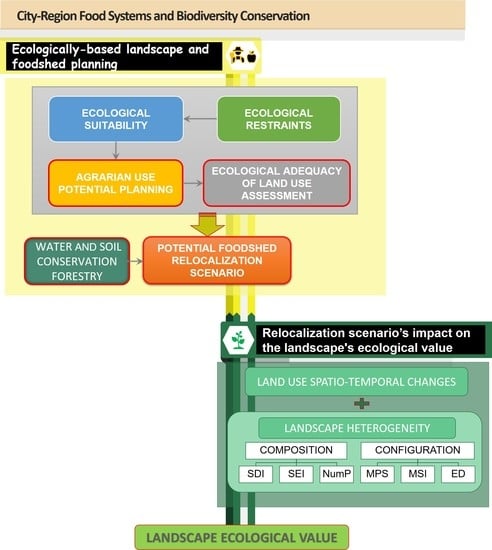City-Region Food Systems and Biodiversity Conservation: The Case Study of the Entre-Douro-e-Minho Agrarian Region
Abstract
:1. Introduction
Main Goals and Findings
2. Materials and Methods
2.1. The Study Area
2.2. Methodological Approach
2.2.1. Ecologically Based Landscape and Foodshed Planning
2.2.2. Relocalization Scenario’s Impact on the Landscape’s Ecological Value
3. Results
3.1. Potential Foodshed Relocalization Scenario
3.2. Spatio-Temporal Changes in Occupation and Land Use
3.3. Spatial Characterization of the Landscape
4. Discussion
5. Conclusions
Supplementary Materials
Author Contributions
Funding
Institutional Review Board Statement
Data Availability Statement
Conflicts of Interest
| 1 | NUTS is an acronym for “Nomenclature Units for Territorial Statistics” established by Eurostat to provide a single uniform breakdown of territorial units for the production of regional statistics for the European Union (EU). The nomenclature encloses 3 levels (i.e., NUTS I, NUTS II, and NUTS III) defined according to population, administrative and geographical criteria. NUTS III correspond to the territory of Intermunicipal Entities. In 2015 a new regional division took place in Portugal—NUTS 2013. |
References
- McKenzie, F.C.; Williams, J. Sustainable food production: Constraints, challenges and choices by 2050. Food Secur. 2015, 7, 221–233. [Google Scholar] [CrossRef]
- DeClerck, F.A.J.; Jones, S.K.; Attwood, S.; Bossio, D.; Girvetz, E.; Chaplin-Kramer, B.; Enfors, E.; Fremier, A.; Gordon, L.; Kizito, F.; et al. Agricultural ecosystems and their services: The vanguard of sustainability? Curr. Opin. Environ. Sustain. 2016, 23, 92–99. [Google Scholar] [CrossRef] [Green Version]
- Willett, W.; Rockström, J.; Loken, B.; Springmann, M.; Lang, T.; Vermeulen, S.; Garnett, T.; Tilman, D.; DeClerck, F.; Wood, A.; et al. Food in the Anthropocene: The EAT–Lancet Commission on healthy diets from sustainable food systems. Lancet 2019, 393, 447–492. [Google Scholar] [CrossRef]
- Bisoffi, S.; Ahrné, L.; Aschemann-Witzel, J.; Báldi, A.; Cuhls, K.; DeClerck, F.; Duncan, J.; Hansen, H.O.; Hudson, R.L.; Kohl, J.; et al. COVID-19 and Sustainable Food Systems: What Should We Learn Before the Next Emergency. Front. Sustain. Food Syst. 2021, 5, 650987. [Google Scholar] [CrossRef]
- Garnett, T. Three perspectives on sustainable food security: Efficiency, demand restraint, food system transformation. What role for life cycle assessment? J. Clean. Prod. 2014, 73, 10–18. [Google Scholar] [CrossRef]
- Morgan, K.; Sonnino, R. The urban foodscape: World cities and the new food equation. Camb. J. Reg. Econ. Soc. 2010, 3, 209–224. [Google Scholar] [CrossRef]
- Blay-Palmer, A.; Santini, G.; Dubbeling, M.; Renting, H.; Taguchi, M.; Giordano, T. Validating the City Region Food System Approach: Enacting Inclusive, Transformational City Region Food Systems. Sustainability 2018, 10, 1680. [Google Scholar] [CrossRef] [Green Version]
- Dubbeling, M.; Renting, H.; Hoekstra, F.; Wiskerke, J.S.C.; Carey, J. City Region Food Systems. Urban Agric. Mag. 2015, 29, 1–72. Available online: https://research.wur.nl/en/publications/city-region-food-systems (accessed on 28 January 2022).
- Vicente-Vicente, J.; Sanz-Sanz, E.; Napoléone, C.; Moulery, M.; Piorr, A. Foodshed, Agricultural Diversification and Self-Sufficiency Assessment: Beyond the Isotropic Circle Foodshed—A Case Study from Avignon (France). Agriculture 2021, 11, 143. [Google Scholar] [CrossRef]
- Schreiber, K.; Hickey, G.M.; Metson, G.S.; Robinson, B.E.; MacDonald, G.K. Quantifying the foodshed: A systematic review of urban food flow and local food self-sufficiency research. Environ. Res. Lett. 2020, 16, 023003. [Google Scholar] [CrossRef]
- Dubbeling, M.; Santini, G.; Renting, H.; Taguchi, M.; Lançon, L.; Zuluaga, J.; de Paoli, L.; Rodriguez, A.; Andino, V. Assessing and Planning Sustainable City Region Food Systems: Insights from Two Latin American Cities. Sustainability 2017, 9, 1455. [Google Scholar] [CrossRef] [Green Version]
- Lengnick, L.; Miller, M.; Marten, G.G. Metropolitan foodsheds: A resilient response to the climate change challenge? J. Environ. Stud. Sci. 2015, 5, 573–592. [Google Scholar] [CrossRef]
- Kriewald, S.; Pradhan, P.; Costa, L.; Ros, A.G.C.; Kropp, J.P. Hungry cities: How local food self-sufficiency relates to climate change, diets, and urbanisation. Environ. Res. Lett. 2019, 14, 094007. [Google Scholar] [CrossRef]
- D’Amour, C.B.; Reitsma, F.; Baiocchi, G.; Barthel, S.; Güneralp, B.; Erb, K.-H.; Haberl, H.; Creutzig, F.; Seto, K.C. Future urban land expansion and implications for global croplands. Proc. Natl. Acad. Sci. USA 2017, 114, 8939–8944. [Google Scholar] [CrossRef] [Green Version]
- Horst, M.; Gaolach, B. The potential of local food systems in North America: A review of foodshed analyses. Renew. Agric. Food Syst. 2015, 30, 399–407. [Google Scholar] [CrossRef]
- Zasada, I.; Schmutz, U.; Wascher, D.; Kneafsey, M.; Corsi, S.; Mazzocchi, C.; Monaco, F.; Piorr, A. Food beyond the City—Analysing Foodsheds and Self-Sufficiency for Different Food System Scenarios in European Metropolitan Regions. City Cult. Soc. 2019, 16, 25–35. [Google Scholar] [CrossRef]
- Cardoso, A.S.; Domingos, T.; de Magalhães, M.R.; de Melo-Abreu, J.; Palma, J. Mapping the Lisbon Potential Foodshed in Ribatejo e Oeste: A Suitability and Yield Model for Assessing the Potential for Localized Food Production. Sustainability 2017, 9, 2003. [Google Scholar] [CrossRef] [Green Version]
- Fraňková, E.; Haas, W.; Singh Editors, S.J. Human-Environment Interactions 7 Socio-Metabolic Perspectives on the Sustainability of Local Food Systems; Springer International Publishing: Berlin/Heidelberg, Germany, 2017; Available online: http://www.springer.com/series/8599 (accessed on 12 November 2022).
- Lin, B.B.; Philpott, S.M.; Jha, S. The future of urban agriculture and biodiversity-ecosystem services: Challenges and next steps. Basic Appl. Ecol. 2015, 16, 189–201. [Google Scholar] [CrossRef]
- Weinzettel, J.; Hertwich, E.G.; Peters, G.P.; Steen-Olsen, K.; Galli, A. Affluence drives the global displacement of land use. Glob. Environ. Chang. 2013, 23, 433–438. [Google Scholar] [CrossRef] [Green Version]
- Pérez-Neira, D.; Grollmus-Venegas, A. Life-cycle energy assessment and carbon footprint of peri-urban horticulture. A comparative case study of local food systems in Spain. Landsc. Urban Plan. 2018, 172, 60–68. [Google Scholar] [CrossRef]
- Dorward, C.; Smukler, S.M.; Mullinix, K. A novel methodology to assess land-based food self-reliance in the Southwest British Columbia bioregion. Renew. Agric. Food Syst. 2017, 32, 112–130. Available online: https://www.cambridge.org/core/journals/renewable-agriculture-and-food-systems/article/novel-methodology-to-assess-landbased-food-selfreliance-in-the-southwest-british-columbia-bioregion/781198BD9ED49150F9E5990938972464 (accessed on 30 January 2022). [CrossRef]
- Joseph, S.; Peters, I.; Friedrich, H. Can Regional Organic Agriculture Feed the Regional Community? A Case Study for Hamburg and North Germany. Ecol Econ. 2019, 164, 106342. [Google Scholar] [CrossRef]
- Padró, R.; Tello, E.; Marco, I.; Olarieta, J.; Grasa, M.; Font, C. Modelling the scaling up of sustainable farming into Agroecology Territories: Potentials and bottlenecks at the landscape level in a Mediterranean case study. J. Clean. Prod. 2020, 275, 124043. [Google Scholar] [CrossRef]
- Weber, C.L.; Matthews, H.S. Food-Miles and the Relative Climate Impacts of Food Choices in the United States. Environ. Sci. Technol. 2008, 42, 3508–3513. [Google Scholar] [CrossRef] [Green Version]
- Edwards-Jones, G.; i Canals, L.M.; Hounsome, N.; Truninger, M.; Koerber, G.; Hounsome, B.; Cross, P.; York, E.H.; Hospido, A.; Plassmann, K.; et al. Testing the assertion that ‘local food is best’: The challenges of an evidence-based approach. Trends Food Sci. Technol. 2008, 19, 265–274. [Google Scholar] [CrossRef]
- Tello, E.; de Molina, M.G. Methodological Challenges and General Criteria for Assessing and Designing Local Sustainable Agri-Food Systems: A Socio-Ecological Approach at Landscape Level. In Socio-Metabolic Perspectives on the Sustainability of Local Food Systems; Springer: Cham, Switzerland, 2017; pp. 27–67. Available online: https://link.springer.com/chapter/10.1007/978-3-319-69236-4_2 (accessed on 27 October 2022).
- Cordell, H.K.; Murphy, D.; Riitters, K.H.; Harvard, J.E. The natural ecological value of wilderness. Mult. Values Wilderness 2005, 14, 205–249. Available online: https://www.srs.fs.usda.gov/pubs/ja/ja_cordell017.pdf (accessed on 1 February 2022).
- Lomba, A.; Alves, P.; Jongman, R.H.G.; McCracken, D.I. Reconciling nature conservation and traditional farming practices: A spatially explicit framework to assess the extent of High Nature Value farmlands in the European countryside. Ecol. Evol. 2015, 5, 1031–1044. [Google Scholar] [CrossRef]
- Amador-Cruz, F.; Figueroa-Rangel, B.L.; Olvera-Vargas, M.; Mendoza, M.E. A systematic review on the definition, criteria, indicators, methods and applications behind the Ecological Value term. Ecol. Indic. 2021, 129, 107856. [Google Scholar] [CrossRef]
- Fahrig, L.; Baudry, J.; Brotons, L.; Burel, F.G.; Crist, T.O.; Fuller, R.J.; Sirami, C.; Siriwardena, G.M.; Martin, J.-L. Functional landscape heterogeneity and animal biodiversity in agricultural landscapes. Ecol. Lett. 2011, 14, 101–112. [Google Scholar] [CrossRef]
- Underwood, E.C.; Hutchinson, R.A.; Viers, J.H.; Rodd, K.T.; Distler, T.; Marty, J.; Conservancy, T.N.; California, A.; Kelsey, T.R. Quantifying Trade-Offs Among Ecosystem Services, Biodiversity, and Agricultural Returns in an Agriculturally Dominated Landscape Under Future Land-Management Scenarios. San Franc. Estuary Watershed Sci. 2017, 15. [Google Scholar] [CrossRef] [Green Version]
- IPBES. Global Assessment Report on Biodiversity and Ecosystem Services of the Intergovernmental Science-Policy Platform on Biodiversity and Ecosystem Services. 2019. Available online: https://zenodo.org/record/5657041 (accessed on 20 January 2022).
- Benton, T.G.; Vickery, J.A.; Wilson, J.D. Farmland biodiversity: Is habitat heterogeneity the key? Trends Ecol. Evol. 2003, 18, 182–188. [Google Scholar] [CrossRef]
- Halada, L.; Evans, D.; Romão, C.; Petersen, J.E. Which habitats of European importance depend on agricultural practices? Biodivers. Conserv. 2011, 20, 2365–2378. [Google Scholar] [CrossRef]
- Kazemi, H.; Klug, H.; Kamkar, B. New services and roles of biodiversity in modern agroecosystems: A review. Ecol. Indic. 2018, 93, 1126–1135. [Google Scholar] [CrossRef]
- Honrado, J.P.; Lomba, A.; Alves, P.; Aguiar, C.; Monteiro-Henriques, T.; Cerqueira, Y.; Monteiro, P.; Caldas, F.B. Conservation Management of EU Priority Habitats after Collapse of Traditional Pastoralism: Navigating Socioecological Transitions in Mountain Rangeland. Rural. Sociol. 2017, 82, 101–128. [Google Scholar] [CrossRef] [Green Version]
- Rosa-Schleich, J.; Loos, J.; Mußhoff, O.; Tscharntke, T. Ecological-economic trade-offs of Diversified Farming Systems—A review. Ecol. Econ. 2019, 160, 251–263. [Google Scholar] [CrossRef]
- Lomba, A.; Moreira, F.; Klimek, S.; Jongman, R.H.; Sullivan, C.; Moran, J.; Poux, X.; Honrado, J.P.; Pinto-Correia, T.; Plieninger, T.; et al. Back to the future: Rethinking socioecological systems underlying high nature value farmlands. Front. Ecol. Environ. 2020, 18, 36–42. [Google Scholar] [CrossRef] [Green Version]
- Schindler, S.; von Wehrden, H.; Poirazidis, K.; Wrbka, T.; Kati, V. Multiscale performance of landscape metrics as indicators of species richness of plants, insects and vertebrates. Ecol. Indic. 2013, 31, 41–48. [Google Scholar] [CrossRef]
- Ethier, K.; Fahrig, L. Positive effects of forest fragmentation, independent of forest amount, on bat abundance in eastern Ontario, Canada. Landsc. Ecol. 2011, 26, 865–876. [Google Scholar] [CrossRef]
- Morelli, F. High nature value farmland increases taxonomic diversity, functional richness and evolutionary uniqueness of bird communities. Ecol. Indic. 2018, 90, 540–546. [Google Scholar] [CrossRef]
- Monck-Whipp, L.; Martin, A.E.; Francis, C.M.; Fahrig, L. Farmland heterogeneity benefits bats in agricultural landscapes. Agric. Ecosyst. Environ. 2018, 253, 131–139. [Google Scholar] [CrossRef]
- Jiao, Y.; Ding, Y.; Zha, Z.; Okuro, T. Crises of Biodiversity and Ecosystem Services in Satoyama Landscape of Japan: A Review on the Role of Management. Sustainability 2019, 11, 454. [Google Scholar] [CrossRef] [Green Version]
- Lomba, A.; Buchadas, A.; Corbelle-Rico, E.; Jongman, R.; McCracken, D. Detecting temporal changes in the extent of High Nature Value farmlands: The case-study of the Entre-Douro-e-Minho Region, Portugal. Landsc. Urban Plan. 2020, 195. [Google Scholar] [CrossRef]
- Buchadas, A.; Moreira, F.; McCracken, D.; Santos, J.L.; Lomba, A. Assessing the potential delivery of ecosystem services by farmlands under contrasting management intensities. Ecol. Soc. 2022, 27, 5. [Google Scholar] [CrossRef]
- Andersen, E.; Baldock, D.; Bennett, H.; Beaufoy, G.; Bignal, E.; Bouwer, F.; Elbersen, B.; Eiden, G.; Godeschalk, F.; Jones, G.; et al. Developing a High Nature Value Farming area indicator. Final Report. 2003. Report for the European Environment Agency, Copenhagen. Available online: http://www.eea.europa.eu/data-and-maps/indicators/agriculture-area-under-management-practices/developing-a-high-nature-value (accessed on 12 November 2022).
- Paracchini, M.L.; Petersen, J.E.; Hoogeveen, Y.; Bamps, C.; Burfield, I.; van Swaay, C. High Nature Value Farmland in Europe. 2008. Available online: https://op.europa.eu/en/publication-detail/-/publication/10604b27-10b3-46c7-83f6-e7202684c36a/language-en (accessed on 12 November 2022).
- Oppermann, R.; Beaufoy, G.; Jones, G. High Nature Value Farming in Europe: 35 European Countries—Experiences and Perspectives; Verlag Regionalkultur: Ubstadt-Weiher, Germany, 2012. [Google Scholar]
- Plieninger, T.; Bieling, C. Resilience-Based Perspectives to Guiding High-Nature-Value Farmland through Socioeconomic Change. Ecol. Soc. 2013, 18, 20. [Google Scholar] [CrossRef] [Green Version]
- Keenleyside, C.; Beaufoy, G.; Tucker, G.; Jones, G. High Nature Value Farming throughout EU-27 and Its Financial Support under the CAP. 2014. Available online: http://www.efncp.org/ (accessed on 4 February 2022).
- INE. Portal do INE. 2021. Available online: https://www.ine.pt/xportal/xmain?xpid=INE&xpgid=ine_indicadores&contecto=pi&indOcorrCod=0011166&selTab=tab0 (accessed on 7 August 2021).
- Agroconsultores e Geometral. Carta dos Solos e Carta da Aptidão da Terra de Entre-Douro e Minho; Escala 1/100000; Peças Desenhadas e Memórias Descritivas; Direcção Regional de Agricultura de Entre Douro e Minho: Braga, Portugal, 1995. [Google Scholar]
- Caetano, M.; Carrao, H.; Painho, M. Alterações da Ocupação do Espaço do Solo em Portugal Continental: 1985–2000; Balint, G., Antala, B., Carty, C., Mabieme, J.M.A., Amar, I.B., Kaplanova, A., Eds.; Instituto do Ambiente: Lisboa, Portugal, 2005; Available online: https://novaresearch.unl.pt/en/publications/altera%C3%A7%C3%B5es-da-ocupa%C3%A7%C3%A3o-do-espa%C3%A7o-do-solo-em-portugal-continental- (accessed on 8 February 2022).
- INE/DGT. Documento Metodológico. Estatísticas de Uso e Ocupação do Solo. Versão 1.1. 2020. Available online: http://smi.ine.pt/DocumentacaoMetodologica/Detalhes/1604. (accessed on 22 November 2022).
- Delgado. Expansão Urbana e Fragmentação de áreas com Forte Aptidão Agrícola o caso de Estudo da “Bacia Leiteira Primária” de Entre-Douro-e-Minho [Tese Mestrado]. Faculdade de Letras da Universidade do Porto. 2010. Available online: https://www.academia.edu/392272/Expans%C3%A3o_Urbana_e_Fragmenta%C3%A7%C3%A3o_de_%C3%81reas_com_Forte_Aptid%C3%A3o_Agr%C3%ADcola_O_caso_de_estudo_da_bacia_leiteira_prim%C3%A1ria_de_Entre_Douro_e_Minho (accessed on 16 November 2022).
- ICNF. Informação Geográfica. 2021. Available online: https://geocatalogo.icnf.pt/catalogo.html (accessed on 16 November 2022).
- Ahern, J. Integration of Landscape Ecology and Landscape Architecture: An Evolutionary and Reciprocal Process. Issues Perspect. Landsc. Ecol. 2005, 307–315. Available online: https://www.cambridge.org/core/books/issues-and-perspectives-in-landscape-ecology/integration-of-landscape-ecology-and-landscape-architecture-an-evolutionary-and-reciprocal-process/8446FF82E7BC18F1287A5282770A49C1 (accessed on 30 January 2022).
- Hendrix, W.G.; Fabos, J.G.; Price, J.E. An ecological approach to landscape planning using geographic information system technology. Landsc. Urban Plan. 1988, 15, 211–225. [Google Scholar] [CrossRef]
- Magalhães, M.R. Estrutura Ecológica Nacional uma Proposta de Delimitação e Regulamentação; ISApress: Lisboa, Portugal, 2019. [Google Scholar]
- Magalhães, M.R.; Abreu, M.M.; Cortez, N.; Lousã, M. Estrutura Ecológica da Paisagem. In Conceitos e Delimitação—Escalas Regional e Municipal; Magalhães, M., Abreu, M., Cortez, N., Lousã, M., Eds.; ISApress: Lisboa, Portugal, 2007; p. 361. [Google Scholar]
- Cortez, N. Sub-sistema Solo. Estrutura Ecológica da Paisagem Conceitos e Delimitação—Escalas Regional e Municipal; Magalhães, M.R., Ed.; ISApress: Lisboa, Portugal, 2007; pp. 52–57. [Google Scholar]
- Leitão, M.; Cortez, N.; Pena, S.B. Valor Ecológico do Solo de Portugal Continental. LEAF/ISA/ULisboa. 2013. Available online: http://epic-webgis-portugal.isa.utl.pt/ (accessed on 27 October 2022).
- Cunha, N.S.; Magalhães, M.R.; Abreu, M.M. Morfologia do Terreno de Portugal Continental. LEAF/ISA/ULisboa. 2013. Available online: http://epic-webgis-portugal.isa.utl.pt/ (accessed on 27 October 2022).
- Costantini, E.A.C. Manual of Methods for Soil and Land Evaluation; CRC Press: Boca Raton, FL, USA, 2009; 564p. [Google Scholar]
- LEAF (ex-CEAP). Declives de Portugal Continental.LEAF/ISA/ULisboa. 2013. Available online: http://epic-webgis-portugal.isa.ulisboa.pt/data/metadata (accessed on 27 October 2022).
- Magalhães, M.R. (Ed.) Ordem Ecológica e Desenvolvimento. In O Futuro do Território Português; ISApress: Lisboa, Portugal, 2015. [Google Scholar]
- Silva, J.F.; Lopes, A.M.; Cunha, N.S.; Abreu, M.M.; Magalhães, M.R. Litoral de Portugal Continental. LEAF/ISA/ULisboa. 2013. Available online: http://epic-webgis-portugal.isa.ulisboa.pt/data (accessed on 27 October 2022).
- Mesquita, S. Vegetação Natural e Semi-natural com Valor de Conservação em Portugal Continental. LEAF/ISA/ULisboa. 2013. Available online: http://epic-webgis-portugal.isa.utl.pt/ (accessed on 27 October 2022).
- FAO. Chapter 3: Land suitability classifications. In A Framework for Land Evaluation Soils Bulletin 32; FAO: Rome, Italy, 1976; pp. 1–9. Available online: http://www.fao.org/3/X5310E/x5310e00.htm (accessed on 27 October 2022).
- Barata, L.T.; Cardoso, A.S.; Cortez, N.; Varennes, A. Cartografia da Espessura Efectiva dos Solos de Portugal Continental. LEAF/ISA/ULisboa. 2015. Available online: http://epic-webgis-portugal.isa.utl.pt/ (accessed on 27 October 2022).
- ESRI. ArcGIS Desktop; Environmental Systems Research Institute: Redlands, CA, USA, 2012. [Google Scholar]
- Brooks, T.M.; Mittermeier, R.A.; Da Fonseca, G.A.B.; Gerlach, J.; Hoffmann, M.; Lamoreux, J.F.; Mittermeier, C.G.; Pilgrim, J.D.; Rodrigues, A.S.L. Global Biodiversity Conservation Priorities. Science 2006, 313, 58–61. [Google Scholar] [CrossRef] [PubMed] [Green Version]
- Baral, H.; Keenan, R.J.; Sharma, S.K.; Stork, N.E.; Kasel, S. Spatial assessment and mapping of biodiversity and conservation priorities in a heavily modified and fragmented production landscape in north-central Victoria, Australia. Ecol. Indic. 2014, 36, 552–562. [Google Scholar] [CrossRef]
- Lomba, A.; Guerra, C.; Alonso, J.; Honrado, J.P.; Jongman, R.; McCracken, D. Mapping and monitoring High Nature Value farmlands: Challenges in European landscapes. J. Environ. Manag. 2014, 143, 140–150. [Google Scholar] [CrossRef]
- Rutledge, D.T. Landscape Indices as Measures of the Effects of Fragmentation: Can Pattern Reflect Process? Department of Conservation: Wellington, New Zealand, 2003; 27p. [Google Scholar]
- Lindenmayer, D.; Cunningham, R.; Donnelly, C.; Lesslie, R. On the use of landscape surrogates as ecological indicators in fragmented forests. For. Ecol. Manag. 2002, 159, 203–216. [Google Scholar] [CrossRef]
- Magalhães, M.; Cunha, N.; Pena, S.; Müller, A. FIRELAN—An Ecologically Based Planning Model towards a Fire Resilient and Sustainable Landscape. A Case Study in Center Region of Portugal. Sustainability 2021, 13, 7055. [Google Scholar] [CrossRef]
- Malucelli, F.; Certini, G.; Scalenghe, R. Soil is brown gold in the Emilia-Romagna region, Italy. Land Use Policy 2014, 39, 350–357. [Google Scholar] [CrossRef]
- Gardi, C.; Panagos, P.; van Liedekerke, M.; Bosco, C.; de Brogniez, D. Land take and food security: Assessment of land take on the agricultural production in Europe. J. Environ. Plan. Manag. 2015, 58, 898–912. [Google Scholar] [CrossRef]
- Cunha, N.; Magalhães, M. Methodology for mapping the national ecological network to mainland Portugal: A planning tool towards a green infrastructure. Ecol. Indic. 2019, 104, 802–818. [Google Scholar] [CrossRef]
- Haberl, H. Competition for land: A sociometabolic perspective. Ecol. Econ. 2015, 119, 424–431. [Google Scholar] [CrossRef] [Green Version]
- Sánchez, R.; Cuellar, M. Coastal interdune agroecosystems in the Mediterranean: A case study of the Andalusian navazo. Agroecol. Sustain. Food Syst. 2016, 40, 895–921. [Google Scholar] [CrossRef]
- Aguiar, A.; Melo, A.; Mansilha, C.; Ferreira, I. Vegetables Production in Nw Portugal, Agriculture Practices and Groundwater Quality. Acta Hortic. 2012, 61–70. [Google Scholar] [CrossRef]
- Padró, R.; Tello, E. Exploring Agroecology Transition Scenarios: A Pfaundler’s Spectrum Assessment on the Relocation of Agri-Food Flows. Land 2022, 11, 824. [Google Scholar] [CrossRef]
- Proença, V.M.; Pereira, H.M.; Guilherme, J.; Vicente, L. Plant and bird diversity in natural forests and in native and exotic plantations in NW Portugal. Acta Oecologica 2010, 36, 219–226. [Google Scholar] [CrossRef]
- Tereso, J.; Martín-Seijo, M.; Gonçalves, J. Florestas do Norte de Portugal—História, Ecologia e Desafios de Gestão. InBio-Rede de Investigação em Biodiversidade e Biologia Evolutiva. Porto; 2011; p. 436. Available online: https://www.academia.edu/5301127/Florestas_do_Norte_de_Portugal_Hist%C3%B3ria_Ecologia_e_Desafios_de_Gest%C3%A3o (accessed on 1 February 2022).
- Moreira, F.; Vaz, P.; Catry, F.; Silva, J. Regional variations in wildfire susceptibility of land-cover types in Portugal: Implications for landscape management to minimize fire hazard. Int. J. Wildland Fire 2009, 18, 563–574. [Google Scholar] [CrossRef]
- Moreira, F.; Viedma, O.; Arianoutsou, M.; Curt, T.; Koutsias, N.; Rigolot, E.; Barbati, A.; Corona, P.; Vaz, P.; Xanthopoulos, G.; et al. Landscape – wildfire interactions in southern Europe: Implications for landscape management. J. Environ. Manag. 2011, 92, 2389–2402. [Google Scholar] [CrossRef] [Green Version]
- Paillet, Y.; Bergès, L.; Hjältén, J.; Ódor, P.; Avon, C.; Bernhardt-Römermann, M.; Bijlsma, R.-J.; De Bruyn, L.; Fuhr, M.; Grandin, U.; et al. Biodiversity Differences between Managed and Unmanaged Forests: Meta-Analysis of Species Richness in Europe. Conserv. Biol. 2010, 24, 101–112. [Google Scholar] [CrossRef]
- Renetzeder, C.; Schindler, S.; Peterseil, J.; Prinz, M.A.; Mücher, S.; Wrbka, T. Can we measure ecological sustainability? Landscape pattern as an indicator for naturalness and land use intensity at regional, national and European level. Ecol. Indic. 2010, 10, 39–48. [Google Scholar] [CrossRef]
- Carrara, E.; Arroyo-Rodríguez, V.; Vega-Rivera, J.H.; Schondube, J.E.; de Freitas, S.M.; Fahrig, L. Impact of landscape composition and configuration on forest specialist and generalist bird species in the fragmented Lacandona rainforest, Mexico. Biol. Conserv. 2015, 184, 117–126. [Google Scholar] [CrossRef]
- Fahrig, L. Landscape heterogeneity and metapopulation dynamics. Key Top. Landsc. Ecol. 2007, 78–91. [Google Scholar] [CrossRef]
- Dixon, A.P.; Baker, M.E.; Ellis, E.C. Agricultural Landscape Composition Linked with Acoustic Measures of Avian Diversity. Land 2020, 9, 145. [Google Scholar] [CrossRef]
- Maskell, L.; Botham, M.; Henrys, P.; Jarvis, S.; Maxwell, D.; Robinson, D.; Rowland, C.; Siriwardena, G.; Smart, S.; Skates, J.; et al. Exploring relationships between land use intensity, habitat heterogeneity and biodiversity to identify and monitor areas of High Nature Value farming. Biol. Conserv. 2019, 231, 30–38. [Google Scholar] [CrossRef]
- Smith, A.C.; Fahrig, L.; Francis, C.M. Landscape size affects the relative importance of habitat amount, habitat fragmentation, and matrix quality on forest birds. Ecography 2011, 34, 103–113. [Google Scholar] [CrossRef]
- Ewers, R.M.; Didham, R.K. Confounding factors in the detection of species responses to habitat fragmentation. Biol. Rev. 2006, 81, 117–142. Available online: https://www.cambridge.org/core/journals/biological-reviews/article/confounding-factors-in-the-detection-of-species-responses-to-habitat-fragmentation/0130DC168C742E216A52E83EF709125B (accessed on 9 February 2022). [CrossRef]
- Newbold, T.; Hudson, L.N.; Phillips, H.R.P.; Hill, S.L.L.; Contu, S.; Lysenko, I.; Blandon, A.; Butchart, S.H.M.; Booth, H.L.; Day, J.; et al. A global model of the response of tropical and sub-tropical forest biodiversity to anthropogenic pressures. Proc. R. Soc. B Boil. Sci. 2014, 281, 20141371. [Google Scholar] [CrossRef] [Green Version]
- Dunning, J.B.; Danielson, B.J.; Pulliam, H.R. Ecological processes that effect populations in complex landscapes. Oikos 1992, 65, 169–175. [Google Scholar] [CrossRef] [Green Version]
- Uuemaa, E.; Antrop, M.; Roosaare, J.; Marja, R.; Mander, U. Landscape Metrics and Indices: An Overview of Their Use in Landscape Research. Living Rev. Landsc. Res. 2009, 3, 1–28. [Google Scholar] [CrossRef]
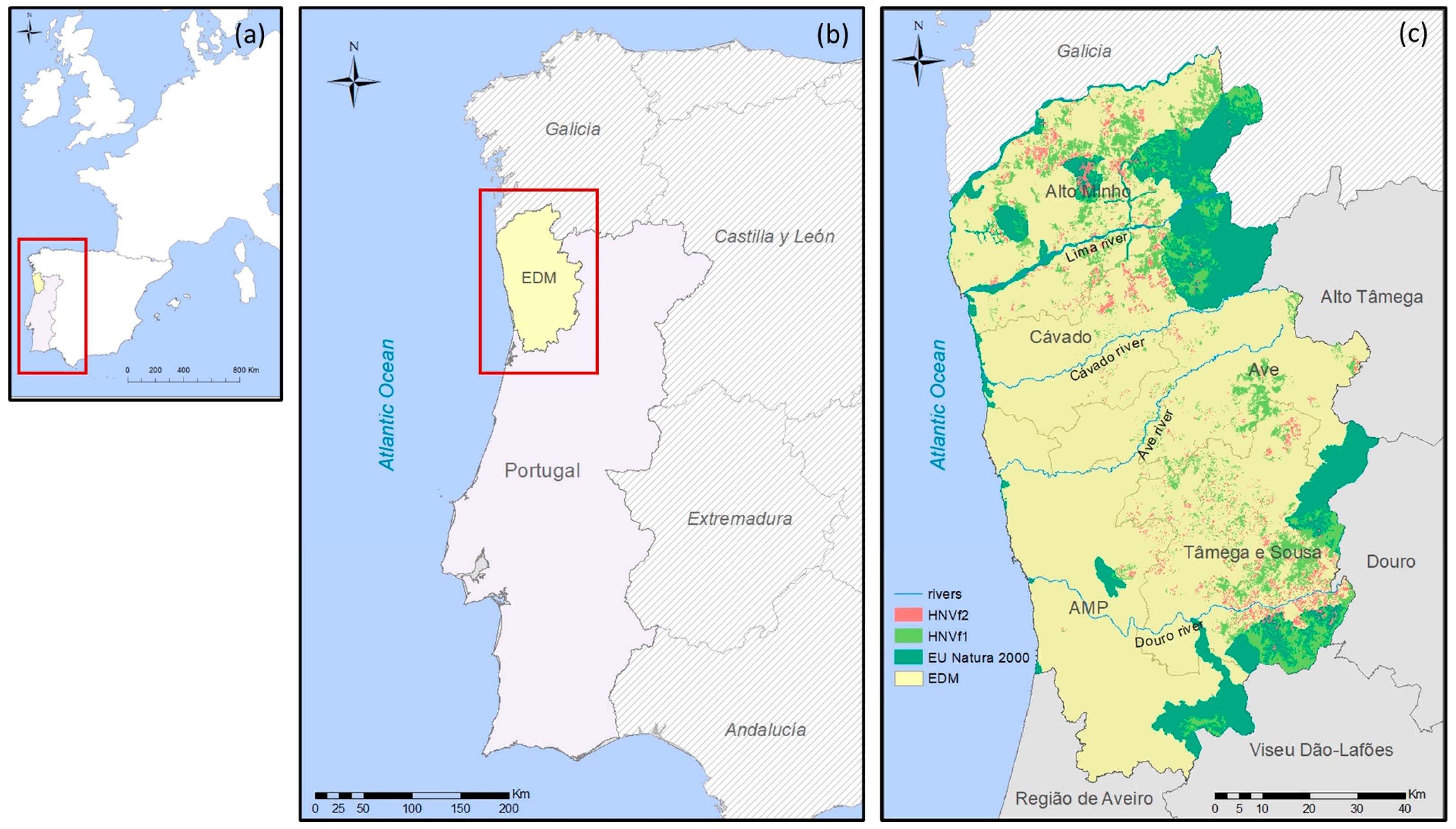
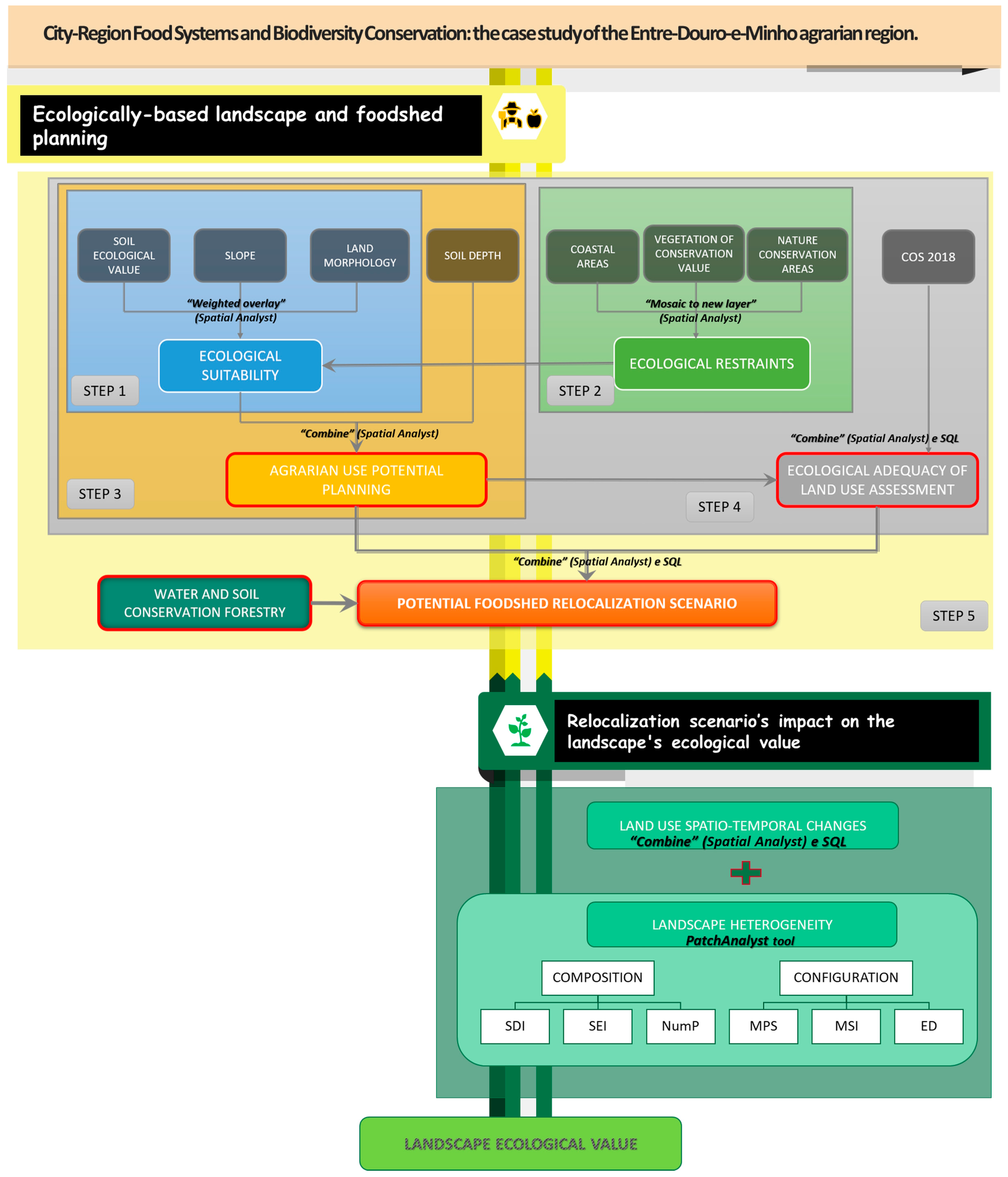
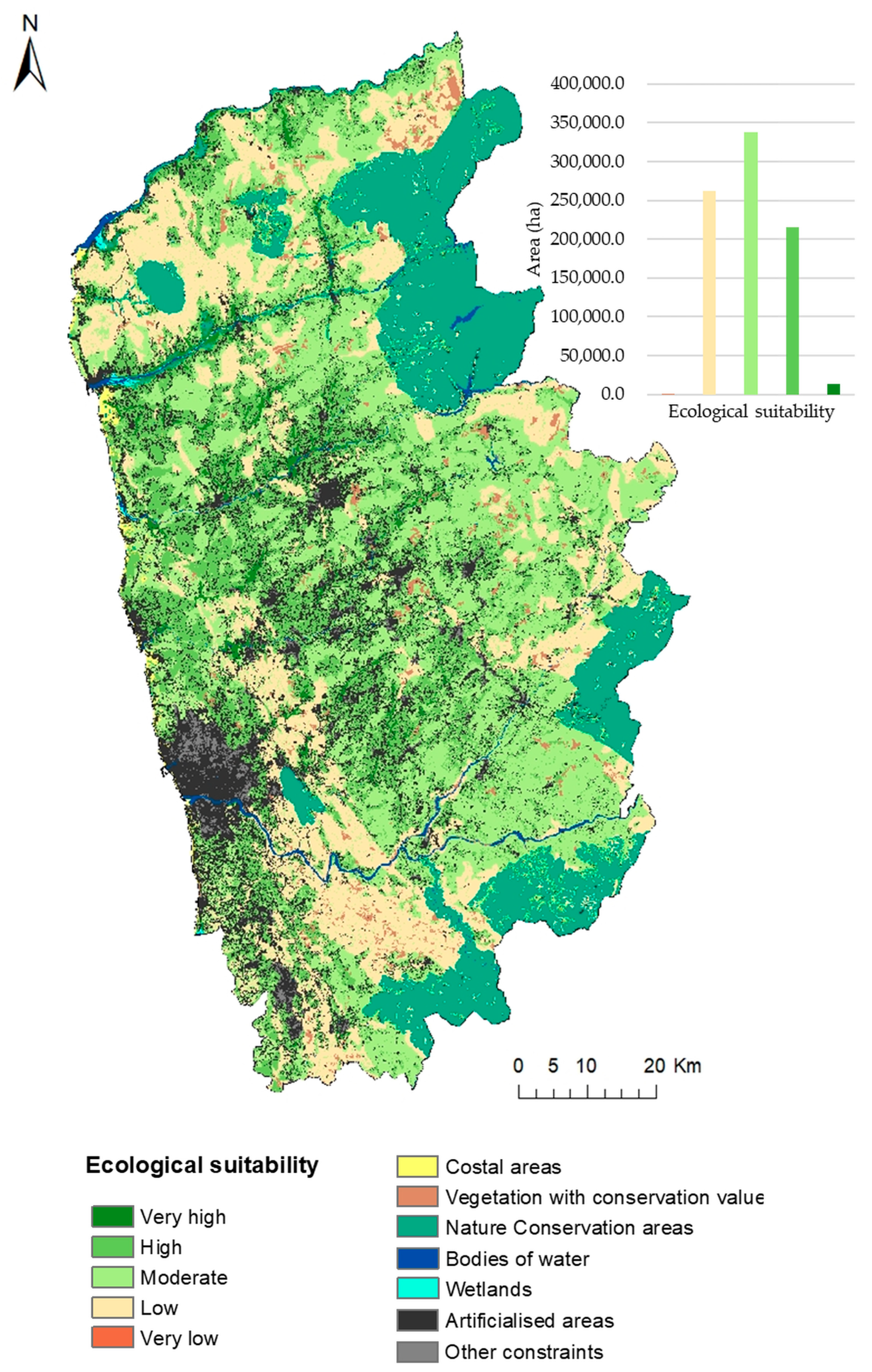
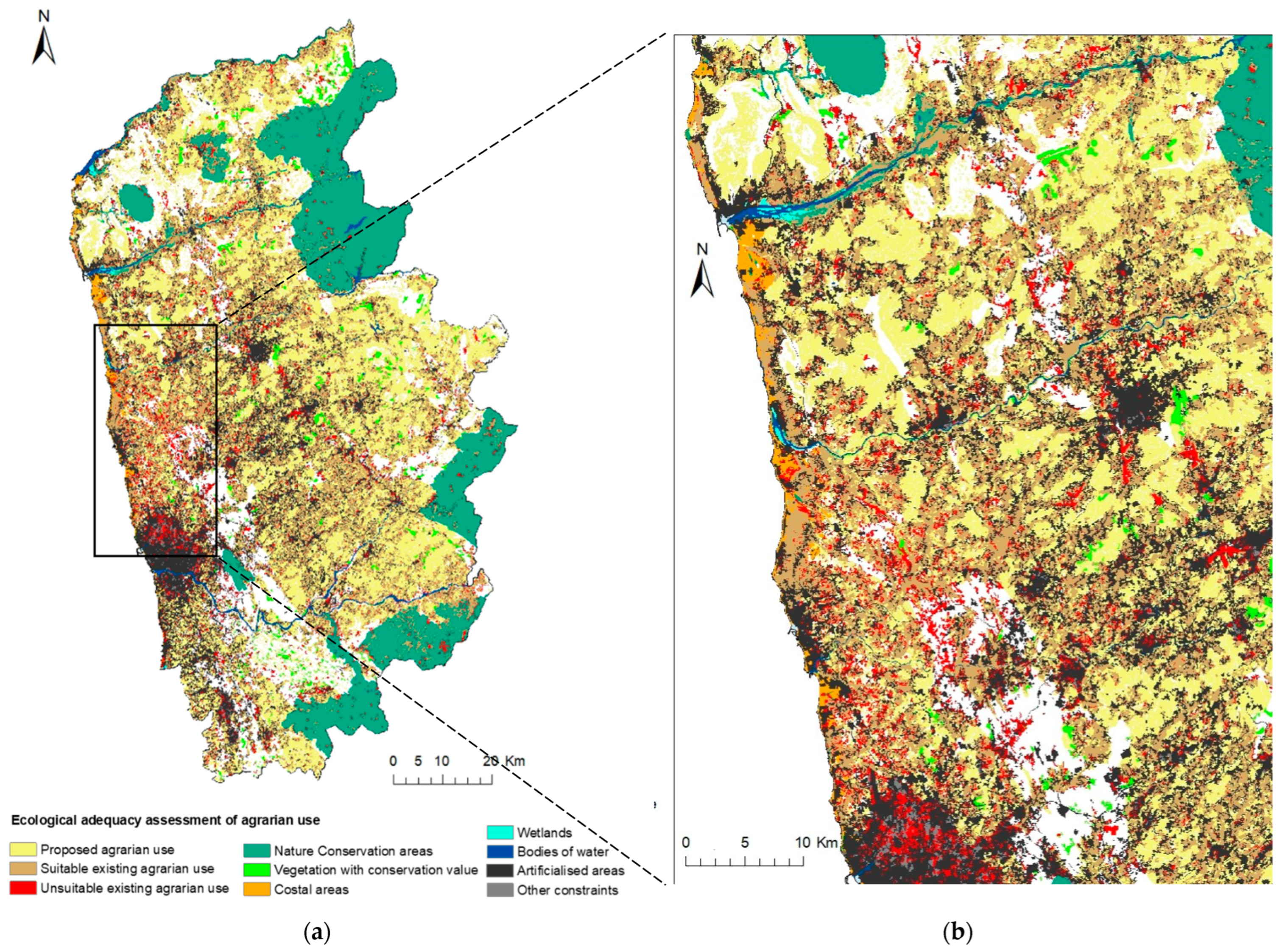
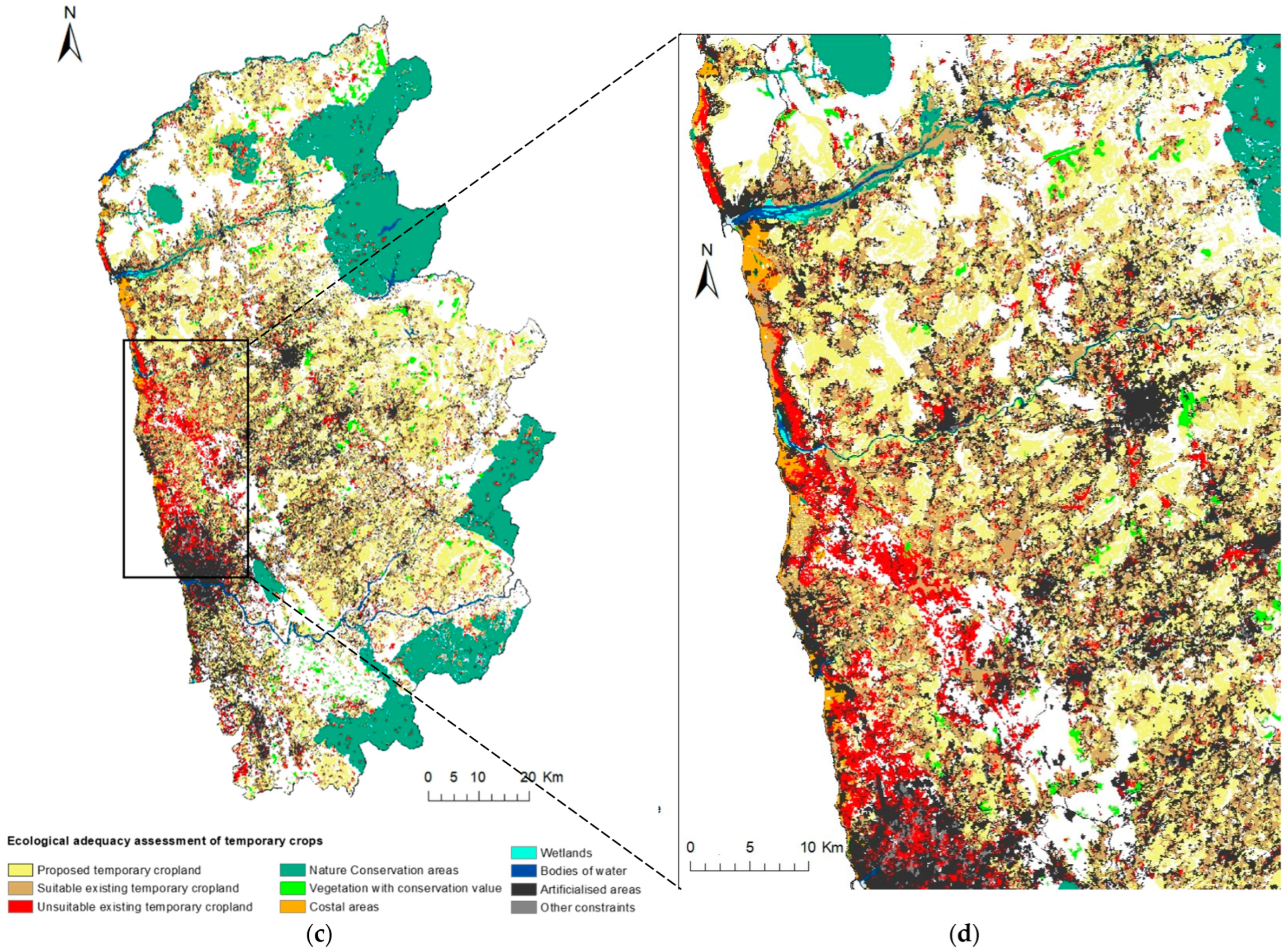
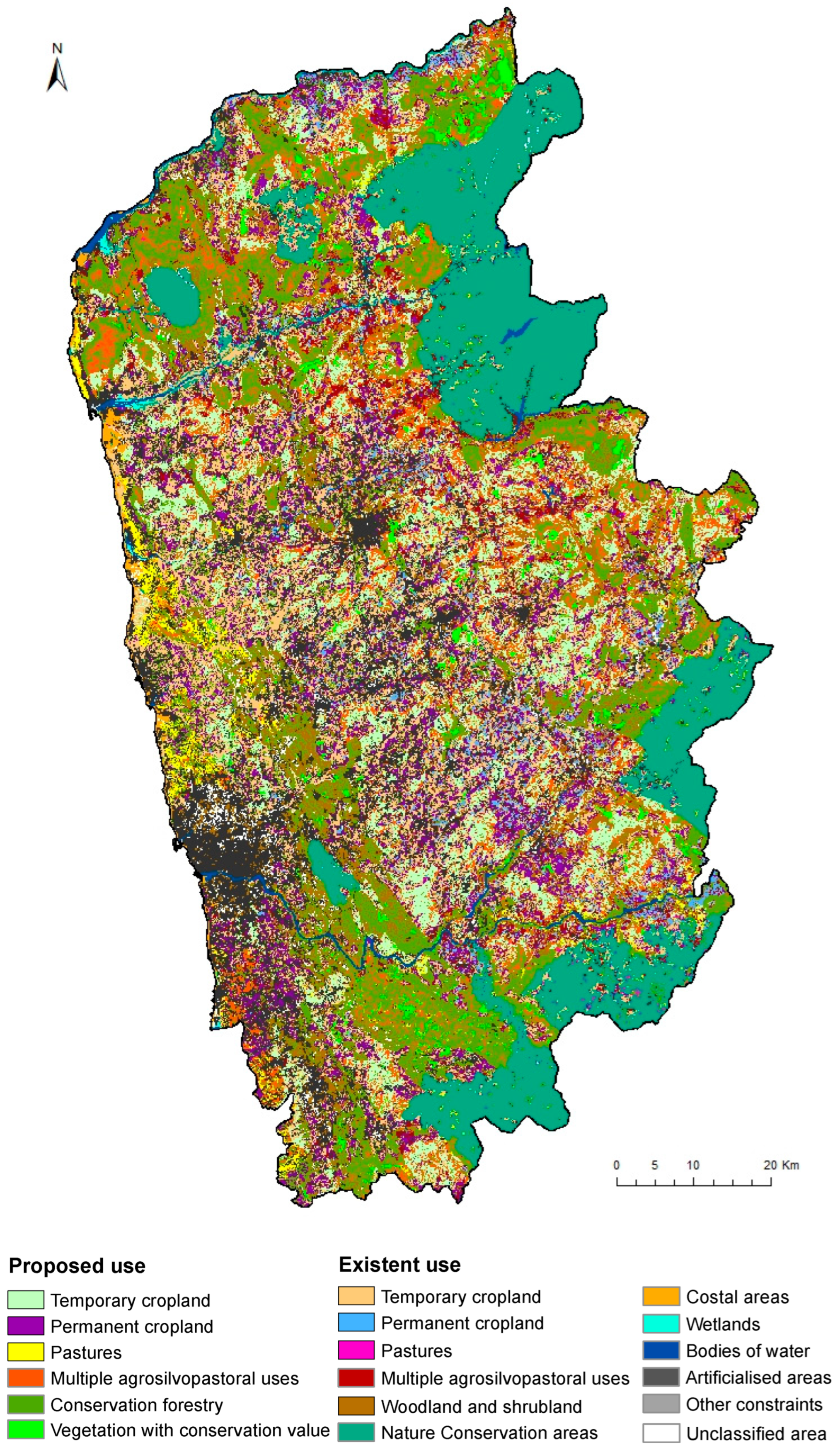
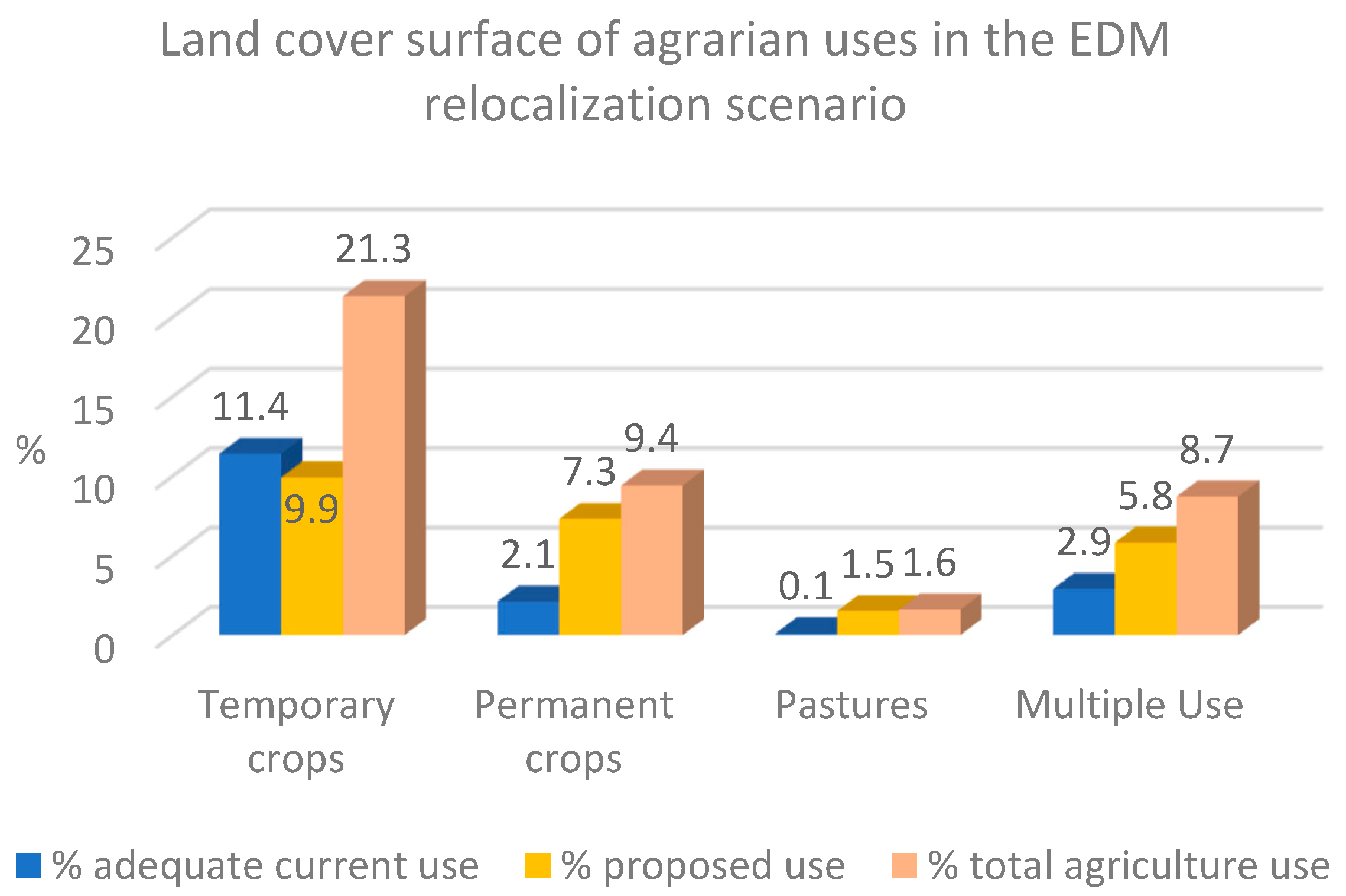

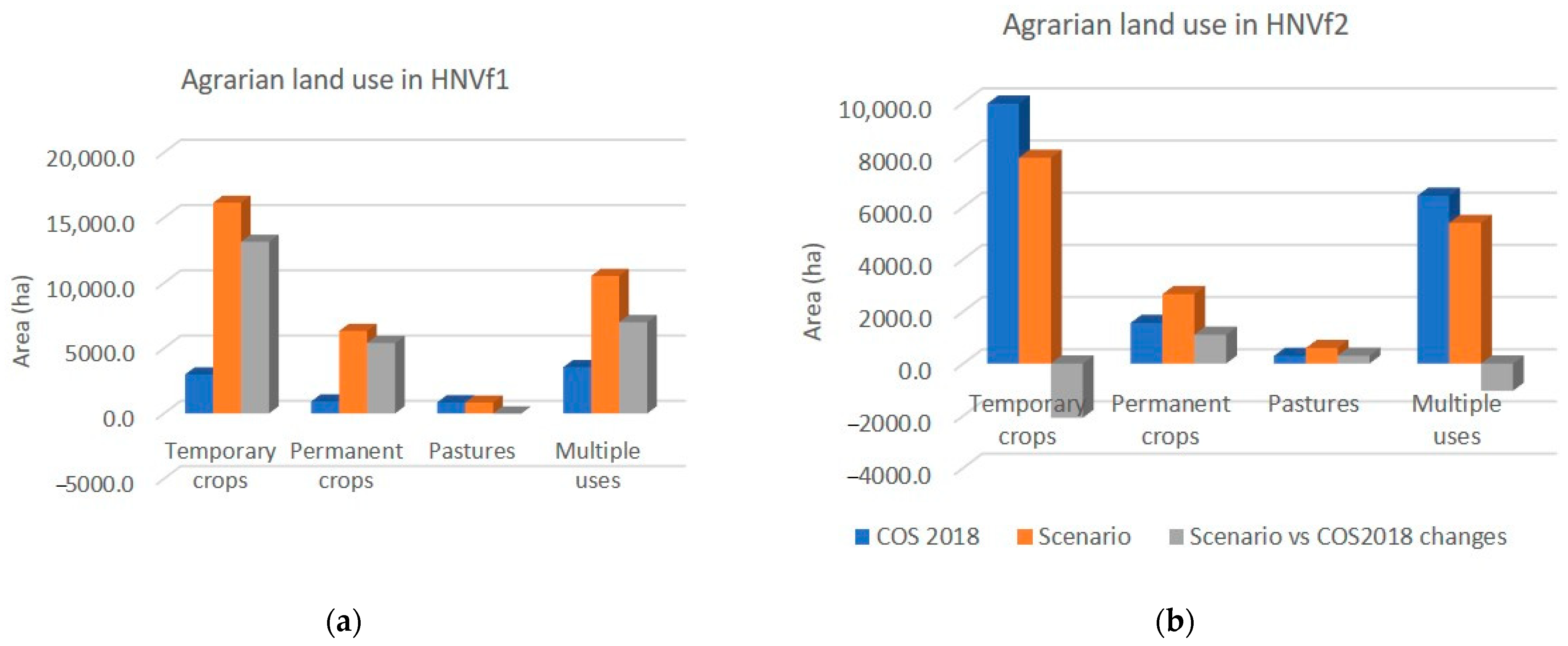
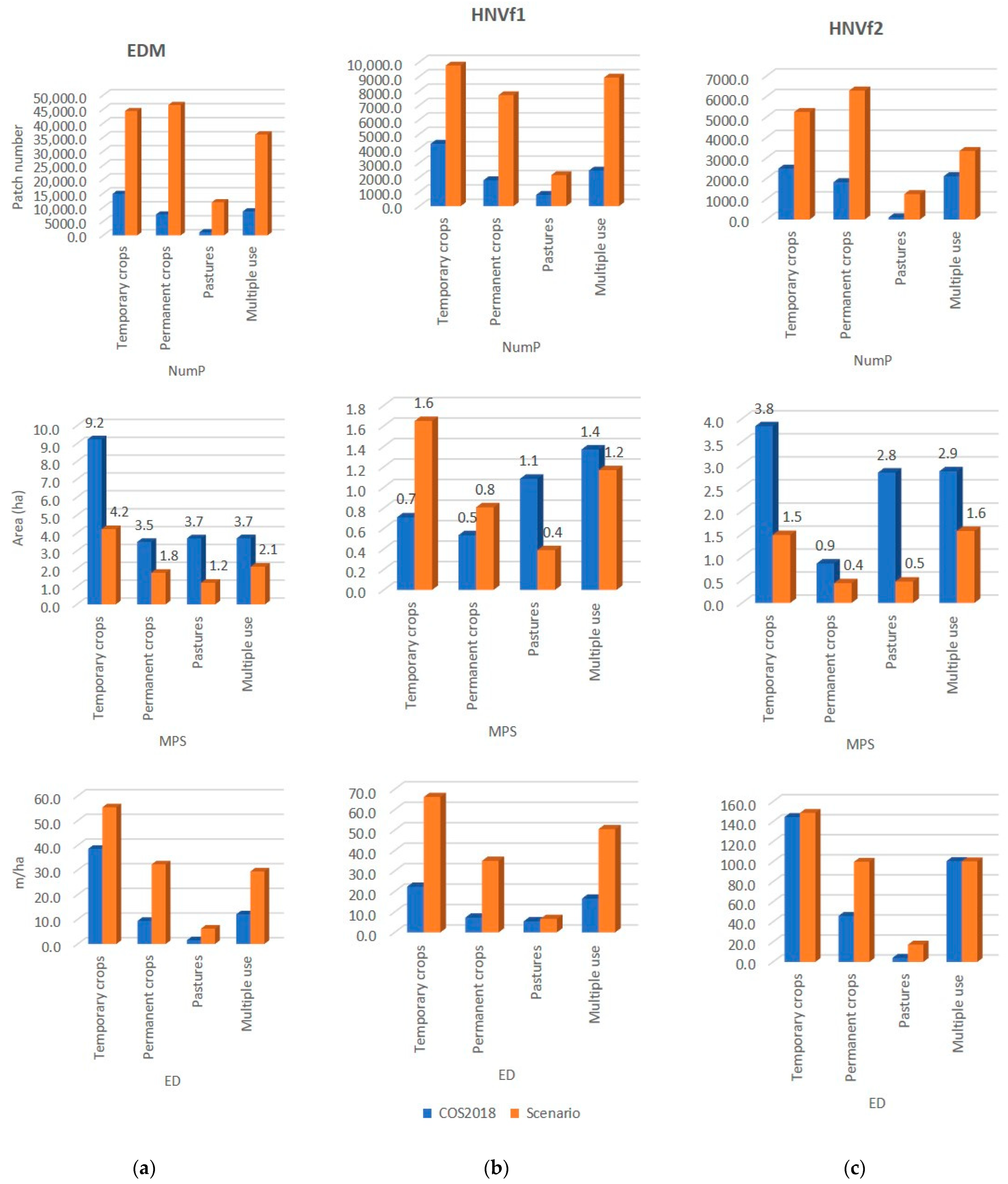
| Suitability | Soil Ecological Value | Slope (%) | Soil Depth (cm) | Notes | |
|---|---|---|---|---|---|
| Temporary crops | 3 to 5 | 3 to 5 | <25 | >25 | Constraints according to the different slope classes * |
| Permanent crops | 3 to 5 | 3 to 5 | <45 | >50 | |
| Pastures | 2 to 3 | 2 | <16 | >25 | |
| 3 | 16 to 45 | ||||
| Multiple agrosilvopastoral uses | 2 to 4 | 2 | <16 | >25 | |
| 3 to 5 | 16 to 45 |
| Suitability | Soil Ecological Value | Slope (%) | Soil Depth (cm) | Notes | |
|---|---|---|---|---|---|
| General agrarian use | 2 to 5 | 2 | <16 | >25 | Constraints according to the different slope classes * |
| 3 to 5 | 16 to 45 |
Disclaimer/Publisher’s Note: The statements, opinions and data contained in all publications are solely those of the individual author(s) and contributor(s) and not of MDPI and/or the editor(s). MDPI and/or the editor(s) disclaim responsibility for any injury to people or property resulting from any ideas, methods, instructions or products referred to in the content. |
© 2023 by the authors. Licensee MDPI, Basel, Switzerland. This article is an open access article distributed under the terms and conditions of the Creative Commons Attribution (CC BY) license (https://creativecommons.org/licenses/by/4.0/).
Share and Cite
Filipe, M.; Lomba, A.; Honrado, J.P.; Cardoso, A.S. City-Region Food Systems and Biodiversity Conservation: The Case Study of the Entre-Douro-e-Minho Agrarian Region. Sustainability 2023, 15, 5021. https://doi.org/10.3390/su15065021
Filipe M, Lomba A, Honrado JP, Cardoso AS. City-Region Food Systems and Biodiversity Conservation: The Case Study of the Entre-Douro-e-Minho Agrarian Region. Sustainability. 2023; 15(6):5021. https://doi.org/10.3390/su15065021
Chicago/Turabian StyleFilipe, Mariana, Angela Lomba, João Pradinho Honrado, and Andreia Saavedra Cardoso. 2023. "City-Region Food Systems and Biodiversity Conservation: The Case Study of the Entre-Douro-e-Minho Agrarian Region" Sustainability 15, no. 6: 5021. https://doi.org/10.3390/su15065021
APA StyleFilipe, M., Lomba, A., Honrado, J. P., & Cardoso, A. S. (2023). City-Region Food Systems and Biodiversity Conservation: The Case Study of the Entre-Douro-e-Minho Agrarian Region. Sustainability, 15(6), 5021. https://doi.org/10.3390/su15065021







